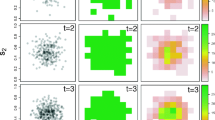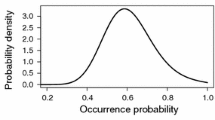Abstract
The statistical ecology develops rapidly with the advancement of analyzing technology and method. This paper made a review about statistical ecology in China in following aspects: data collection, spatial and time patterns analysis, species-abundance and species-area relations, population dynamic, species affinity, community similarity and community cluster analysis, and community ordination.
Similar content being viewed by others
References
Cao Guangxia. 1991. Life table ofPicea purpurea andAbies jaxoniana. Acta ecologica sinica,11(3)
Chen Jihong 1993. The study on the law of aboveground biomass growth of the main plant communities in Songnen grassland. (Master Theses). Harbin: Northeast Forestry University
Greig-Smith, P. 1983. Quantitative plant ecology. Oxford London Edinburgh, Boston Melbourne
Guo Yiquan and Zhao Zhimo. 1992. The measurement of the similarity among the communities food nets, Chinese Journal of ecology 11(3)
Liu Xinghua. 1992. Preliminary study on the niche of plant population inLeymus chinensis steppe. (Master Theses). Harbin: Northeast Forestry University
Ludwing, J.A. and Reynolds, J.F. 1988. Statistical Ecology—a primer on methods and computing. Awiley-interscience Publication John Wiley and Sons
Ma Keming. 1994. A FRACTAL study on horizontal distribution pattern ofAneurolepldium chinensis community. (Master Theses) Harbin: Northeast Forestry University.
Pielou, E.C. 1991. Mathematical Ecology. Science Press
Southwood, T.R.C. 1984. Ecological Methods with particular reference to the study of insect populations. Science Press
Su Xiangyao and Lin Changshan. 1986. The study on the model of Mythimna separates population dynamics. Acta ecologica sinica,6(1)
Wan Bosun. 1987. The dynamics of the dominant populations in Ding hu-shan. Acta ecologica sinica,7(3)
Wang Yihong 1990. The experimental methods of forest ecology. Harbin: Northeast Forestry University Press.
Whittaker, R.H. 1986. Ordination of plant communities, Science Press
Whittaker, R.H. 1985. Classification of plant communities, Science Press
Wu Jincai and Pang Xiongfei. 1990. The Mathematical models of multispecies population preying and its forecast inNilaparvata lugens. Acta ecologica Sinica,10(3)
Wu Yuming. 1991. Environmental statistics. China Environmental Science Press
Xia Naibing. 1992. The analysis of the diffuse trends of Chinese pine caterpillar larvae in its tree climbing time sequences. Acta ecologica sinica,12(1)
Zhou Jizhong. 1987. The preying action of pirate subpiratious toNiaparvata lugens and its model research. Acta ecologica sinica,7(4)
Zhang Xijun. 1994. A CTM model for coordinate development of population, resources and environment in Songnen Plain. (Doctoral Dissertation). Harbin: Northeast Forestry University
Zhao Zhimo and Guo Yiquan. 1991. The theory and method of community ecology. Chongqing: Chongqing Science and Technology Press
Zu Yuangang. 1990. Introduction to Energy Ecology. Changcun: Jilin Science and Technology Press
Author information
Authors and Affiliations
Additional information
Responsible editor: Zhu Hong
Rights and permissions
About this article
Cite this article
Wanli, Z. Development and application of the statistical ecology in China. Journal of Forestry Research 10, 173–177 (1999). https://doi.org/10.1007/BF02855426
Received:
Issue Date:
DOI: https://doi.org/10.1007/BF02855426




